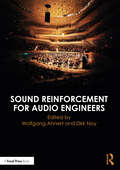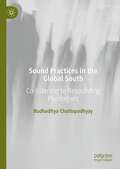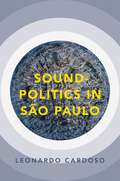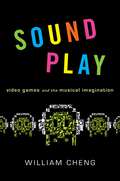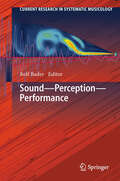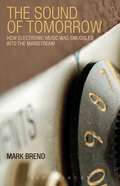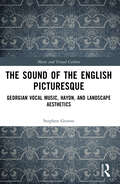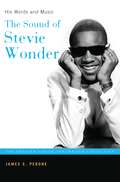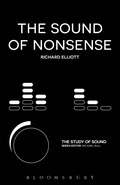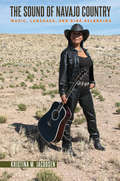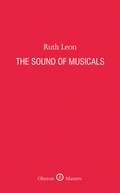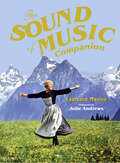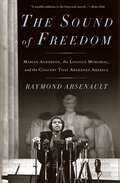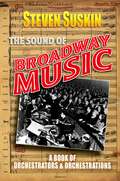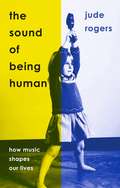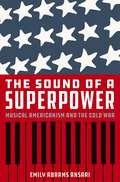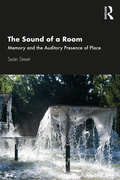- Table View
- List View
Sound Reinforcement for Audio Engineers
by Wolfgang AhnertSound Reinforcement for Audio Engineers illustrates the current state of the art in sound reinforcement. Beginning with an outline of various fields of applications, from sports venues to religious venues, corporate environments and cinemas, this book is split into 11 chapters covering room acoustics, loudspeakers, microphones and acoustic modelling among many other topics. This comprehensive book packed with references and a historical overview of sound reinforcement design is an essential reference book for students of acoustics and electrical engineering, but also for engineers looking to expand their knowledge of designing sound reinforcement systems.
Sound Reinforcement for Audio Engineers
by Wolfgang Ahnert Dirk NoySound Reinforcement for Audio Engineers illustrates the current state of the art in sound reinforcement. Beginning with an outline of various fields of applications, from sports venues to religious venues, corporate environments and cinemas, this book is split into 11 chapters covering room acoustics, loudspeakers, microphones and acoustic modelling among many other topics. This comprehensive book packed with references and a historical overview of sound reinforcement design is an essential reference book for students of acoustics and electrical engineering, but also for engineers looking to expand their knowledge of designing sound reinforcement systems.
Sound Practices in the Global South: Co-listening to Resounding Plurilogues
by Budhaditya ChattopadhyayThis book develops a comprehensive understanding of the unique sound worlds of key regions in the Global South, through an auto-ethnographic method of self-reflective conversations with prominent sound practitioners from South Asia, Africa, the Middle East and Latin America. The conversations navigate various trajectories of sound practices, illuminating intricate sonic processes of listening, thinking through sounds, ideating, exposing, and performing with sound. This collection of conversations constitutes the main body of the book, including critical and scholarly commentaries on aural cultures, sound theory and production. The book builds a ground-up approach to nurturing knowledge about aural cultures and sonic aesthetics, moving beyond the Eurocentric focus of contemporary sound studies. Instead of understanding sound practices through consumption and entertainment, they are explored as complex cultural and aesthetic systems, working directly with the practitioners themselves, who largely contribute to the development of the sonic methodologies. Refocusing on the working methods of practitioners, the book reveals a tension between the West’s predominant colonial-consumerist cultures, and the collective desires of practitioners to resist colonial models of listening by expressing themselves in terms of their arts and craft, and their critical faculties.Conversations with: Clarence Barlow, Sandeep Bhagwati, Rajesh K. Mehta, Sharif Sehnaoui, Ximena Alarcón Díaz, Hardi Kurda, Mario de Vega, Luka Mukhavele, Khyam Allami, Cedrik Fermont, Khaled Kaddal, David Velez, Juan Duarte, Youmna Saba, Abdellah M. Hassak, Mariana Marcassa, Amanda Gutiérrez, Syma Tariq, Alma Laprida, Siamak Anvari, Mohamad Safa, Debashis Sinha, Zouheir Atbane, Constanza Bizraelli, Jatin Vidyarthi, Joseph Kamaru, Surabhi Saraf, Isuru Kumarasinghe, Hemant Sreekumar.
SOUND-POLITICS IN SAO PAULO CILAM C (Currents in Latin American and Iberian Music)
by Leonardo CardosoHow does the state separate music from noise? How can such a filtering apparatus shape the content and form of sound production in the city? As a marker of co-presence to the hearing body, sound is always open to (or rather opens up) the politics of shared existence. In the throes of the post-dictatorship period, Brazil's legislative and executive branches implemented a series of sweeping measures to address quality of life concerns, including environmental pollution and urban inequality. In São Paulo, noise control became a recurrent controversy, growing in size and scale between the 1990s and 2010s. Together with the much-debated fear of crime and the socioeconomic and cultural tensions between the rich urban center and the poor peripheries, such ecological agendas against noise as a harmful pollutant have reconfigured the presence of environmental sounds in the city. In this book, Cardoso argues that the framing of specific sounds as unavoidable, unnecessary, or as harmful "noise" has been an effective strategy to organize spaces and administer group behavior in this rapidly expanding city. He focuses on two interrelated processes. First, the series of institutional regulatory mechanisms that turn sounds into the all-embracing "noise" susceptible to state intervention. Second, the constant attempts of interested groups in either attaching or detaching specific sounds (musical events, industrial noise, traffic noise, religious sounds, etc.) from regulatory scrutiny. Sound-politics is the dynamic that emerges from both processes - the channels through which sounds enter (and leave) the sphere of state regulation.
Sound-Politics in São Paulo (Currents in Latin American and Iberian Music)
by Leonardo CardosoHow does the state separate music from noise? How can such a filtering apparatus shape the content and form of sound production in the city? As a marker of co-presence to the hearing body, sound is always open to (or rather opens up) the politics of shared existence. In the throes of the post-dictatorship period, Brazil's legislative and executive branches implemented a series of sweeping measures to address quality of life concerns, including environmental pollution and urban inequality. In São Paulo, noise control became a recurrent controversy, growing in size and scale between the 1990s and 2010s. Together with the much-debated fear of crime and the socioeconomic and cultural tensions between the rich urban center and the poor peripheries, such ecological agendas against noise as a harmful pollutant have reconfigured the presence of environmental sounds in the city. In this book, Cardoso argues that the framing of specific sounds as unavoidable, unnecessary, or as harmful "noise" has been an effective strategy to organize spaces and administer group behavior in this rapidly expanding city. He focuses on two interrelated processes. First, the series of institutional regulatory mechanisms that turn sounds into the all-embracing "noise" susceptible to state intervention. Second, the constant attempts of interested groups in either attaching or detaching specific sounds (musical events, industrial noise, traffic noise, religious sounds, etc.) from regulatory scrutiny. Sound-politics is the dynamic that emerges from both processes - the channels through which sounds enter (and leave) the sphere of state regulation.
Sound Play: Video Games and the Musical Imagination (Oxford Music / Media)
by William ChengVideo games open portals to fantastical worlds where imaginative play and enchantment prevail. These virtual settings afford us considerable freedom to act out with relative impunity. Or do they? Sound Play explores the aesthetic, ethical, and sociopolitical stakes of people's creative engagements with gaming's audio phenomena-from sonorous violence to synthesized operas, from democratic music-making to vocal sexual harassment. William Cheng shows how video games empower their designers, composers, players, critics, and scholars to tinker (often transgressively) with practices and discourses of music, noise, speech, and silence. Faced with collisions between utopian and alarmist stereotypes of video games, Sound Play synthesizes insights across musicology, sociology, anthropology, communications, literary theory, philosophy, and additional disciplines. With case studies spanning Final Fantasy VI, Silent Hill, Fallout 3, The Lord of the Rings Online, and Team Fortress 2, this book insists that what we do in there-in the safe, sound spaces of games-can ultimately teach us a great deal about who we are and what we value (musically, culturally, humanly) out here. Foreword by Richard Leppert Video Games Live cover image printed with permission from Tommy Tallarico
Sound Play: Video Games and the Musical Imagination (Oxford Music / Media)
by William ChengVideo games open portals to fantastical worlds where imaginative play and enchantment prevail. These virtual settings afford us considerable freedom to act out with relative impunity. Or do they? Sound Play explores the aesthetic, ethical, and sociopolitical stakes of people's creative engagements with gaming's audio phenomena-from sonorous violence to synthesized operas, from democratic music-making to vocal sexual harassment. William Cheng shows how video games empower their designers, composers, players, critics, and scholars to tinker (often transgressively) with practices and discourses of music, noise, speech, and silence. Faced with collisions between utopian and alarmist stereotypes of video games, Sound Play synthesizes insights across musicology, sociology, anthropology, communications, literary theory, philosophy, and additional disciplines. With case studies spanning Final Fantasy VI, Silent Hill, Fallout 3, The Lord of the Rings Online, and Team Fortress 2, this book insists that what we do in there-in the safe, sound spaces of games-can ultimately teach us a great deal about who we are and what we value (musically, culturally, humanly) out here. Foreword by Richard Leppert Video Games Live cover image printed with permission from Tommy Tallarico
Sound - Perception - Performance (Current Research in Systematic Musicology #1)
by Rolf BaderMusical Performance covers many aspects like Musical Acoustics, Music Psychology, or motor and prosodic actions. It deals with basic concepts of the origin or music and its evolution, ranges over neurocognitive foundations, and covers computational, technological, or simulation solutions. This volume gives an overview about current research in the foundation of musical performance studies on all these levels. Recent concepts of synchronized systems, evolutionary concepts, basic understanding of performance as Gestalt patterns, theories of chill as performance goals or historical aspects are covered. The neurocognitive basis of motor action in terms of music, musical syntax, as well as therapeutic aspects are discussed. State-of-the-art applications in performance realizations, like virtual room acoustics, virtual musicians, new concepts of real-time physical modeling using complex performance data as input or sensor and gesture studies with soft- and hardware solutions are presented. So although the field is still much larger, this volume presents current trends in terms of understanding, implementing, and perceiving performance.
The Sound of Tomorrow: How Electronic Music Was Smuggled into the Mainstream
by Mark BrendLondon, 1966: Paul McCartney met a group of three electronic musicians called Unit Delta Plus. McCartney was there because he had become fascinated by electronic music, and wanted to know how it was made. He was one of the first rock musicians to grasp its potential, but even he was notably late to the party. For years, composers and technicians had been making electronic music for film and TV. Hitchcock had commissioned a theremin soundtrack for Spellbound (1945); The Forbidden Planet (1956) featured an entirely electronic score; Delia Derbyshire had created the Dr Who theme in 1963; and by the early 1960s, all you had to do was watch commercial TV for a few hours to hear the weird and wonderful sounds of the new world. The Sound of Tomorrow tells the compelling story of the sonic adventurers who first introduced electronic music to the masses. A network of composers, producers, technicians and inventors, they took emerging technology and with it made sound and music that was bracingly new.
The Sound of Tomorrow: How Electronic Music Was Smuggled into the Mainstream
by Mark BrendLondon, 1966: Paul McCartney met a group of three electronic musicians called Unit Delta Plus. McCartney was there because he had become fascinated by electronic music, and wanted to know how it was made. He was one of the first rock musicians to grasp its potential, but even he was notably late to the party. For years, composers and technicians had been making electronic music for film and TV. Hitchcock had commissioned a theremin soundtrack for Spellbound (1945); The Forbidden Planet (1956) featured an entirely electronic score; Delia Derbyshire had created the Dr Who theme in 1963; and by the early 1960s, all you had to do was watch commercial TV for a few hours to hear the weird and wonderful sounds of the new world. The Sound of Tomorrow tells the compelling story of the sonic adventurers who first introduced electronic music to the masses. A network of composers, producers, technicians and inventors, they took emerging technology and with it made sound and music that was bracingly new.
The Sound of the English Picturesque: Georgian Vocal Music, Haydn, and Landscape Aesthetics (Music and Visual Culture)
by Stephen GrovesRevealing the connections between the veneration of national landscape and eighteenth- century English vocal music, this study restores English music’s relationship with the picturesque. In the eighteenth century, the emerging taste for the picturesque was central to British aesthetics, as poets and painters gained popularity by glorifying the local landscape in works concurrent with the emergence of native countryside tourism. Yet English music was seldom discussed as a medium for conveying national scenic beauty. Stephen Groves explores this gap, and shows how secular song, the glee, and national theatre music expressed a uniquely English engagement with landscape. Using an interdisciplinary approach, Groves addresses the apparent ‘silence’ of the English picturesque. The book draws on analysis of the visualisations present in the texts of English vocal music, and their musical treatment, to demonstrate how local composers incorporated celebrations of landscape into their works. The final chapter shows that the English picturesque was a crucial influence on Joseph Haydn’s oratorio The Seasons. Suitable for anyone with an interest in eighteenth- century music, aesthetics, and the natural environment, this book will appeal to a wide range of specialists and non- specialists alike.
The Sound of the English Picturesque: Georgian Vocal Music, Haydn, and Landscape Aesthetics (Music and Visual Culture)
by Stephen GrovesRevealing the connections between the veneration of national landscape and eighteenth- century English vocal music, this study restores English music’s relationship with the picturesque. In the eighteenth century, the emerging taste for the picturesque was central to British aesthetics, as poets and painters gained popularity by glorifying the local landscape in works concurrent with the emergence of native countryside tourism. Yet English music was seldom discussed as a medium for conveying national scenic beauty. Stephen Groves explores this gap, and shows how secular song, the glee, and national theatre music expressed a uniquely English engagement with landscape. Using an interdisciplinary approach, Groves addresses the apparent ‘silence’ of the English picturesque. The book draws on analysis of the visualisations present in the texts of English vocal music, and their musical treatment, to demonstrate how local composers incorporated celebrations of landscape into their works. The final chapter shows that the English picturesque was a crucial influence on Joseph Haydn’s oratorio The Seasons. Suitable for anyone with an interest in eighteenth- century music, aesthetics, and the natural environment, this book will appeal to a wide range of specialists and non- specialists alike.
The Sound of Stevie Wonder: His Words and Music (The Praeger Singer-Songwriter Collection)
by James E. PeroneSince his professional debut in 1962, Stevie Wonder has recorded sixty-four singles that have made the Billboard top 100, including ten that reached number one. Wonder was one of the first Motown artists to have complete control over the writing, arranging, and recording of his songs, and achieved that stature before he was 20 years old. He has won 17 Grammy awards, was elected to the Rock and Roll Hall of Fame in 1989, and earned the Grammy's Lifetime Achievement Award in 1996. Equally important, his work as a producer, arranger, and instrumentalist on other artists' recordings has put him in the highest rank of musical collaborators. This is the first work of criticism on this important documentarian of American life, as well as the introductory volume in The Praeger Singer-Songwriter Collection. Through a combination of biography and critical analysis, James Perone's groundbreaking new book reveals the many ways in which Stevie Wonder's body of work emerged, developed, reflected its time, and influenced myriad other artists.After revealing the social, cultural, and political context of Wonder's work, the book provides detailed analysis of his compositions and recordings, with a focus on both his well-known songs and those known only to his hardcore fans. The volume also contains discussions of cover versions of Wonder's compositions, a discography of his recordings, a song title index, an annotated bibliography, and a general index.
The Sound of Nonsense (The Study of Sound)
by Richard ElliottIn The Sound of Nonsense, Richard Elliott highlights the importance of sound in understanding the 'nonsense' of writers such as Lewis Carroll, Edward Lear, James Joyce and Mervyn Peake, before connecting this noisy writing to works which engage more directly with sound, including sound poetry, experimental music and pop. By emphasising sonic factors, Elliott makes new and fascinating connections between a wide range of artistic examples to ultimately build a case for the importance of sound in creating, maintaining and disrupting meaning.
The Sound of Nonsense (The Study of Sound)
by Richard ElliottIn The Sound of Nonsense, Richard Elliott highlights the importance of sound in understanding the 'nonsense' of writers such as Lewis Carroll, Edward Lear, James Joyce and Mervyn Peake, before connecting this noisy writing to works which engage more directly with sound, including sound poetry, experimental music and pop. By emphasising sonic factors, Elliott makes new and fascinating connections between a wide range of artistic examples to ultimately build a case for the importance of sound in creating, maintaining and disrupting meaning.
The Sound of Navajo Country: Music, Language, and Diné Belonging (Critical Indigeneities)
by Kristina M. JacobsenIn this ethnography of Navajo (Diné) popular music culture, Kristina M. Jacobsen examines questions of Indigenous identity and performance by focusing on the surprising and vibrant Navajo country music scene. Through multiple first-person accounts, Jacobsen illuminates country music’s connections to the Indigenous politics of language and belonging, examining through the lens of music both the politics of difference and many internal distinctions Diné make among themselves and their fellow Navajo citizens. As the second largest tribe in the United States, the Navajo have often been portrayed as a singular and monolithic entity. Using her experience as a singer, lap steel player, and Navajo language learner, Jacobsen challenges this notion, showing the ways Navajos distinguish themselves from one another through musical taste, linguistic abilities, geographic location, physical appearance, degree of Navajo or Indian blood, and class affiliations. By linking cultural anthropology to ethnomusicology, linguistic anthropology, and critical Indigenous studies, Jacobsen shows how Navajo poetics and politics offer important insights into the politics of Indigeneity in Native North America, highlighting the complex ways that identities are negotiated in multiple, often contradictory, spheres.
The Sound of Musicals (Oberon Masters Series)
by Ruth LeonThe world of musicals is beautiful, complex, hilarious, hard-headed, and improbable. It is as hard to make a great musical as it is to fly a spaceship to the moon and there are at least as many moving parts. Why is a great musical as significant a theatrical achievement as, say, King Lear?In this entertaining new title in Oberon Masters Series, Ruth Leon tells all about the composers, the lyricists, the directors and the pioneers of the stage musical on both sides of the Atlantic while trying to reveal the truth behind the eternal question - what are musicals and why do we love them?‘A whirlwind tour through musical theatre history... This book may be small but, like all the great shows about which Leon writes, it is perfectly formed’ - Jewish Chronicle‘A slim and succinct account of the handful of 20th century musicals which, in Leon’s very well informed and experienced opinion, have changed the genre forever... I learned a great deal. Buy it.’ – The Stage‘Light-hearted but informative… with an air of authority… is also beautifully bound: a slim, smart, slightly old-fashioned looking hardback.’ - What’s on stage.com ‘Ruth Leon has the ability to capture the essence of each musical, which is the real strength of pocket-sized hardback… a lovely little volume that will delight any devotee of this genre’ - British Theatre Guide‘A must for any performing arts or drama student.’ - Ink Pellet
The Sound of Music Companion: The Official Companion To The World's Most Beloved Musical
by Laurence MaslonThe definitive book on the world's most beloved musical, TheSound of Music Companion charts the incredible and enduring story of Maria von Trapp and her story over the last hundred years – from Maria's birth in Vienna in 1905 to the 50th anniversary of the film's release in 2015.
The Sound of Freedom: Marian Anderson, the Lincoln Memorial, and the Concert That Awakened America
by Raymond ArsenaultFew moments in Civil Rights history are as important as the morning of Sunday April 9, 1939 when Marian Anderson sang before a throng of thousands lined up along the Mall by the Lincoln Memorial. She had been banned from the Daughters of the American Revolution's Constitution Hall because she was black. When Eleanor Roosevelt, who resigned from the DAR over the incident, took up Anderson's cause, however, it became a national issue. The controversy showed Americans that discrimination was not simply a regional problem. As Arsenault shows, Anderson's dignity and courage enabled her, like a female Jackie Robinson - but several years before him - to strike a vital blow for civil rights.Today the moment still resonates. Postcards and CDs of Anderson are sold at the Memorial and Anderson is still considered one of the greats of 20th century American music. In a short but richly textured narrative, Raymond Arsenault captures the struggle for racial equality in pre-WWII America and a moment that inspired blacks and whites alike. In rising to the occasion, he writes, Marion Anderson "consecrated" the Lincoln Memorial as a shrine of freedom. In the 1963 March on Washington Martin Luther King would follow, literally, in her footsteps.
The Sound of Broadway Music: A Book of Orchestrators and Orchestrations
by Steven SuskinBroadway's top orchestrators - Robert Russell Bennett, Don Walker, Philip J. Lang, Jonathan Tunick - are names well known to musical theatre fans, but few people understand precisely what the orchestrator does. The Sound of Broadway Music is the first book ever written about these unsung stars of the Broadway musical whose work is so vital to each show's success. The book examines the careers of Broadway's major orchestrators and follows the song as it travels from the composer's piano to the orchestra pit. Steven Suskin has meticulously tracked down thousands of original orchestral scores, piecing together enigmatic notes and notations with long-forgotten documents and current interviews with dozens of composers, producers, conductors and arrangers. The information is separated into three main parts: a biographical section which gives a sense of the life and world of twelve major theatre orchestrators, as well as incorporating briefer sections on another thirty arrangers and conductors; a lively discussion of the art of orchestration, written for musical theatre enthusiasts (including those who do not read music); a biographical section which gives a sense of the life and world of twelve major theatre orchestrators, as well as incorporating briefer sections on another thirty arrangers and conductors; and an impressive show-by-show listing of more than seven hundred musicals, in many cases including a song-by-song listing of precisely who orchestrated what along with relevant comments from people involved with the productions. Stocked with intriguing facts and juicy anecdotes, many of which have never before appeared in print, The Sound of Broadway Music brings fascinating and often surprising new insight into the world of musical theatre.
The Sound of Broadway Music: A Book of Orchestrators and Orchestrations
by Steven SuskinBroadway's top orchestrators - Robert Russell Bennett, Don Walker, Philip J. Lang, Jonathan Tunick - are names well known to musical theatre fans, but few people understand precisely what the orchestrator does. The Sound of Broadway Music is the first book ever written about these unsung stars of the Broadway musical whose work is so vital to each show's success. The book examines the careers of Broadway's major orchestrators and follows the song as it travels from the composer's piano to the orchestra pit. Steven Suskin has meticulously tracked down thousands of original orchestral scores, piecing together enigmatic notes and notations with long-forgotten documents and current interviews with dozens of composers, producers, conductors and arrangers. The information is separated into three main parts: a biographical section which gives a sense of the life and world of twelve major theatre orchestrators, as well as incorporating briefer sections on another thirty arrangers and conductors; a lively discussion of the art of orchestration, written for musical theatre enthusiasts (including those who do not read music); a biographical section which gives a sense of the life and world of twelve major theatre orchestrators, as well as incorporating briefer sections on another thirty arrangers and conductors; and an impressive show-by-show listing of more than seven hundred musicals, in many cases including a song-by-song listing of precisely who orchestrated what along with relevant comments from people involved with the productions. Stocked with intriguing facts and juicy anecdotes, many of which have never before appeared in print, The Sound of Broadway Music brings fascinating and often surprising new insight into the world of musical theatre.
The Sound of Being Human: How Music Shapes Our Lives
by Jude Rogers'Too often we treat popular music as wallpaper surrounding us as we live our lives. Jude Rogers shows the emotional and cerebral heft such music can have. It's a personal journey which becomes universal. Fascinating' Ian Rankin'Moving and absorbing, The Sound of Being Human mixes memoir, analysis, anecdote and personal chronicle into a mosaic that evokes what music means to the individual and the human tribe. A candid, beautiful read' Stuart MaconieThe Sound of Being Human explores, in detail, why music plays such a deep-rooted role in so many lives, from before we are born to our last days. At its heart is Jude's own story: how songs helped her wrestle with the grief of losing her father at age five; concoct her own sense of self as a lonely adolescent; sky-rocket her relationships, both real and imagined, in the flushes of early womanhood, propel her own journey into working life, adulthood and parenthood, and look to the future.Shaped around twelve songs, ranging from ABBA's 'Super Trouper' to Neneh Cherry's 'Buffalo Stance', Kraftwerk's 'Radioactivity' to Martha Reeves and the Vandellas' 'Heat Wave', the book combines memoir and historical, scientific and cultural enquiry to show how music can shape different versions of ourselves; how we rely upon music for comfort, for epiphanies, and for sexual and physical connection; how we grow with songs, and songs grow inside us, helping us come to terms with grief, getting older and powerful memories. It is about music's power to help us tell our own stories, whatever they are, and make them sing.
The Sound of a Superpower: Musical Americanism and the Cold War
by Emily Abrams AnsariClassical composers seeking to create an American sound enjoyed unprecedented success during the 1930s and 1940s. Aaron Copland, Roy Harris, Howard Hanson and others brought national and international attention to American composers for the first time in history. In the years after World War II, however, something changed. The prestige of musical Americanism waned rapidly as anti-Communists made accusations against leading Americanist composers. Meanwhile a method of harmonic organization that some considered more Cold War-appropriate--serialism--began to rise in status. For many composers and historians, the Cold War had effectively "killed off" musical Americanism. In The Sound of a Superpower: Musical Americanism and the Cold War, Emily Abrams Ansari offers a fuller, more nuanced picture of the effect of the Cold War on Americanist composers. The ideological conflict brought both challenges and opportunities. Some Americanist composers struggled greatly in this new artistic and political environment. Those with leftist politics sensed a growing gap between the United States that their music imagined and the aggressive global superpower that their nation seemed to be becoming. But these same composers would find unique opportunities to ensure the survival of musical Americanism thanks to the federal government, which wanted to use American music as a Cold War propaganda tool. By serving as advisors to cultural diplomacy programs and touring as artistic ambassadors, the Americanists could bring their now government-backed music to new global audiences. Some with more right-wing politics, meanwhile, would actually flourish in the new ideological environment, by aligning their music with Cold War conceptions of American identity. The Americanists' efforts to safeguard the reputation of their style would have significant consequences. Ultimately, Ansari shows, they effected a rebranding of musical Americanism, with consequences that remain with us today.
The Sound of a Superpower: Musical Americanism and the Cold War
by Emily Abrams AnsariClassical composers seeking to create an American sound enjoyed unprecedented success during the 1930s and 1940s. Aaron Copland, Roy Harris, Howard Hanson and others brought national and international attention to American composers for the first time in history. In the years after World War II, however, something changed. The prestige of musical Americanism waned rapidly as anti-Communists made accusations against leading Americanist composers. Meanwhile a method of harmonic organization that some considered more Cold War-appropriate--serialism--began to rise in status. For many composers and historians, the Cold War had effectively "killed off" musical Americanism. In The Sound of a Superpower: Musical Americanism and the Cold War, Emily Abrams Ansari offers a fuller, more nuanced picture of the effect of the Cold War on Americanist composers. The ideological conflict brought both challenges and opportunities. Some Americanist composers struggled greatly in this new artistic and political environment. Those with leftist politics sensed a growing gap between the United States that their music imagined and the aggressive global superpower that their nation seemed to be becoming. But these same composers would find unique opportunities to ensure the survival of musical Americanism thanks to the federal government, which wanted to use American music as a Cold War propaganda tool. By serving as advisors to cultural diplomacy programs and touring as artistic ambassadors, the Americanists could bring their now government-backed music to new global audiences. Some with more right-wing politics, meanwhile, would actually flourish in the new ideological environment, by aligning their music with Cold War conceptions of American identity. The Americanists' efforts to safeguard the reputation of their style would have significant consequences. Ultimately, Ansari shows, they effected a rebranding of musical Americanism, with consequences that remain with us today.
The Sound of a Room: Memory and the Auditory Presence of Place
by Seán StreetWhat does a place sound like – and how does the sound of place affect our perceptions, experiences, and memories? The Sound of a Room takes a poetic and philosophical approach to exploring these questions, providing a thoughtful investigation of the sonic aesthetics of our lived environments. Moving through a series of location-based case studies, the author uses his own field recordings as the jumping-off point to consider the underlying questions of how sonic environments interact with our ideas of self, sense of creativity, and memories. Advocating an awareness born of deep listening, this book offers practical and poetic insights for researchers, practitioners, and students of sound.
